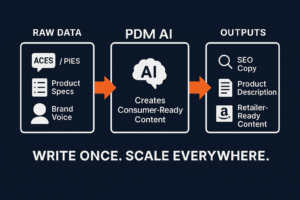Building a successful automotive aftermarket brand in today’s dynamic marketplace goes beyond offering high-quality products that appeal to automotive enthusiasts and professionals alike.
Growth-minded automotive aftermarket businesses must sell their products across multiple eCommerce platforms to achieve long-term success, which can be a huge challenge. Product data such as year, make and model fitment, technical specifications, and product descriptions must be accurately distributed to these multiple platforms simultaneously to provide a seamless shopping experience for customers.
Thanks to the sheer volume of data related to each component and the importance of distributing the correct data to the right location, the challenge of data management is magnified for automotive aftermarket companies.
This is precisely where an advanced Product Information Management (or PIM) system designed to work with aftermarket products comes into play.
Understanding PIM systems
A Product Information Management (PIM) system is an essential tool for centralizing, organizing, and managing a company’s product information. It enables efficient distribution across multiple sales channels and ensures data consistency and quality that drives business growth.
For automotive aftermarket businesses, a PIM serves three crucial functions:
- Managing Product Data: A PIM system organizes product data, which includes descriptions, specifications, pricing, and imagery. This management covers creating, updating, and deleting product information, ensuring consistency and accuracy across all eCommerce platforms.
- Centralizing Information: It consolidates data from various sources into one data repository. This centralization is crucial for businesses dealing with extensive product ranges and multiple data sources, as it provides a singular point of truth for product information.
- Distributing Information Across Platforms: Once centralized, product information is formatted and synchronized across various channels, such as e-commerce platforms, retail partners, and digital marketing channels. This ensures that all stakeholders, from sales teams to end consumers, have access to consistent and up-to-date information.
To achieve these goals, advanced PIM systems must offer several core components that ensure their functionality and effectiveness:
- Data Quality Management: This involves the tools and processes that maintain data accuracy, completeness, and relevance over time. Features such as validation rules, standardization procedures, and duplicate data checks help maintain high-quality data in the PIM system.
- Integration Capabilities: A robust PIM system can integrate seamlessly with other enterprise tools such as ERP (Enterprise Resource Planning), CRM (Customer Relationship Management), and CMS (Content Management Systems). This integration is vital for automating data flow across systems, reducing manual data entry, and minimizing errors.
- Multichannel Data Syndication: This component ensures that product information can be adapted and sent to various channels in the appropriate formats. Whether feeding data into an e-commerce platform, generating print catalogs, or distributing to data pools for marketplaces, the PIM must manage these needs efficiently.
Challenges unique to the automotive aftermarket
While PIM systems are used across every industry, their usage in the automotive industry is crucial due to several factors unique to the automotive space.
Complex Product Data
The automotive aftermarket offers a diverse array of products, each with specifications that can vary significantly depending on the vehicle’s model, make, and year.
Managing this complexity requires a PIM system capable of easily handling ACES and PIES data. The challenge lies in structuring the data to support effective search and retrieval while ensuring straightforward compatibility checks for users, helping them find the right part for the right vehicle configuration without error.
Data Accuracy and Updates
Maintaining data accuracy in the automotive aftermarket is challenging due to the continuous updates required to accommodate new vehicle models, retirements of old models, and changes in automotive regulations.
Parts and components may also undergo redesigns, requiring updates in their descriptions, specifications, and compatibility data. Ensuring that all this information remains accurate and reflects the latest standards is critical to avoid costly mistakes and customer dissatisfaction.
Integration Issues
Integrating a PIM system with other tools, such as an ERP and CRM, presents several challenges.
First, there is often a significant disparity in the data structures between different systems, leading to data consistency and synchronization issues. For example, the ERP system may categorize inventory in a manner that doesn’t align perfectly with how products are categorized in the PIM, leading to discrepancies that can confuse inventory management and sales strategies. Additionally, real-time data sharing between systems can be complex but crucial for maintaining up-to-date inventory levels and customer information across platforms.
Benefits of implementing an automotive aftermarket PIM system
Automotive aftermarket PIM systems are designed to conquer the unique challenges of selling high-quality components across multiple eCommerce platforms.
Before implementing a PIM system, it’s essential for businesses to thoroughly assess their specific needs. This involves understanding the scope of their product data, identifying key challenges in data management, and determining the integration needs with existing systems. This assessment will help select a PIM system that best fits the operational dynamics and objectives of the business.
Integrating a PIM designed to work with the automotive aftermarket will bring several immediate benefits.
Enhanced data management
A PIM system helps automotive aftermarket businesses organize and centralize their complex data sets, which often contain vast amounts of information on parts and components varying by vehicle make, model, and year.
By centralizing this data, businesses can manage it more efficiently, ensuring all product information is consistent and easy to access. This setup significantly reduces errors and inconsistencies in managing data across disparate systems.
Improved customer experience
Customers benefit from reliable information that helps them find the correct parts quickly.
This reliability builds trust and increases customer satisfaction, leading to higher retention rates and more repeat business. Accurate data also supports better customer service interactions by equipping support staff with the information they need to assist customers effectively.
Streamlined operations
PIM systems streamline operations by reducing the overhead of managing complex product data.
They automate key processes such as data entry, update, and syndication across sales channels, which minimizes manual efforts and reduces the likelihood of errors. Additionally, efficient data management supports better inventory control and supply chain management, leading to optimized stock levels and reduced fulfillment times.
Better compliance and reporting
Compliance with regulations is critical in the automotive industry.
A PIM system improves regulatory compliance by updating all product data according to the latest standards and regulations. This system also enhances reporting accuracy, providing precise data that can be used for compliance reports, thus reducing the risk of penalties and enabling quicker responses to regulatory changes.
Scalability
Scalability is one of the fundamental benefits of a Product Information Management (PIM) system, particularly vital for businesses experiencing growth.
As businesses expand their product ranges or enter new markets, PIM systems can scale to accommodate increased data complexity and volume, supporting business growth without compromising data management quality.
PIM systems designed for the automotive aftermarket
Ready to revolutionize how you manage and distribute your automotive product data?
Choose PDM Automotive for a Product Information Management system tailored specifically to the unique needs of the automotive aftermarket. With PDM Automotive, you’ll benefit from enhanced data management capabilities, streamlined operations, and unparalleled scalability to support your growth and expansion.
Don’t let complex data slow you down.
Contact PDM Automotive today to see how we can help you transform your product information into your greatest asset!

More Resources
Elevate Your Brand in the Automotive Aftermarket With These Content Management Strategies



